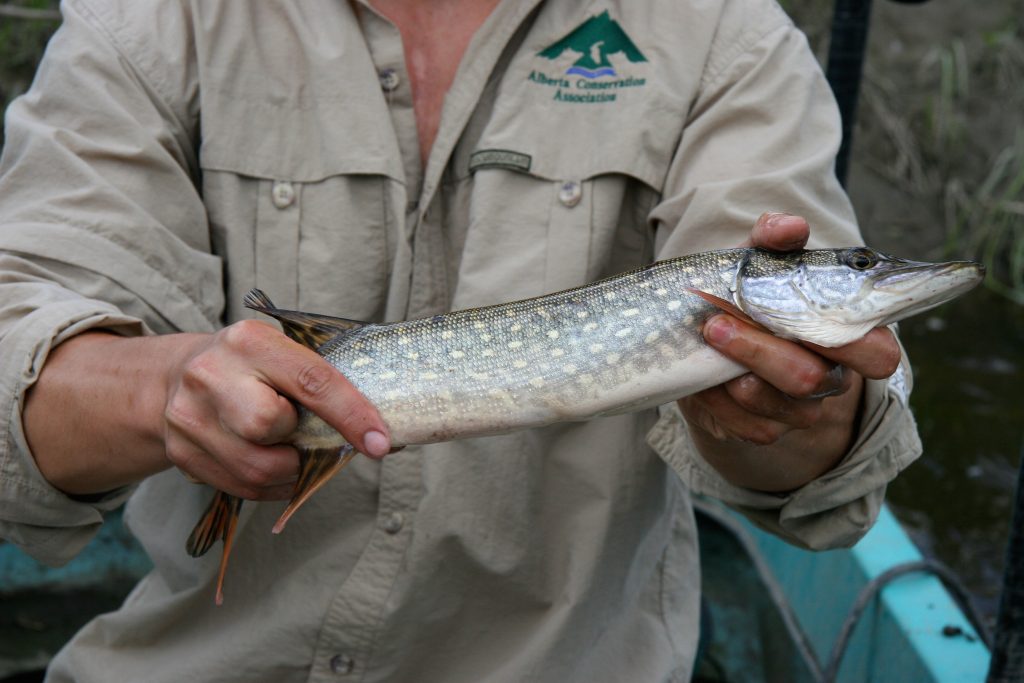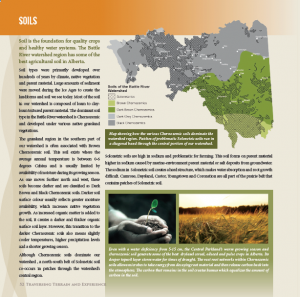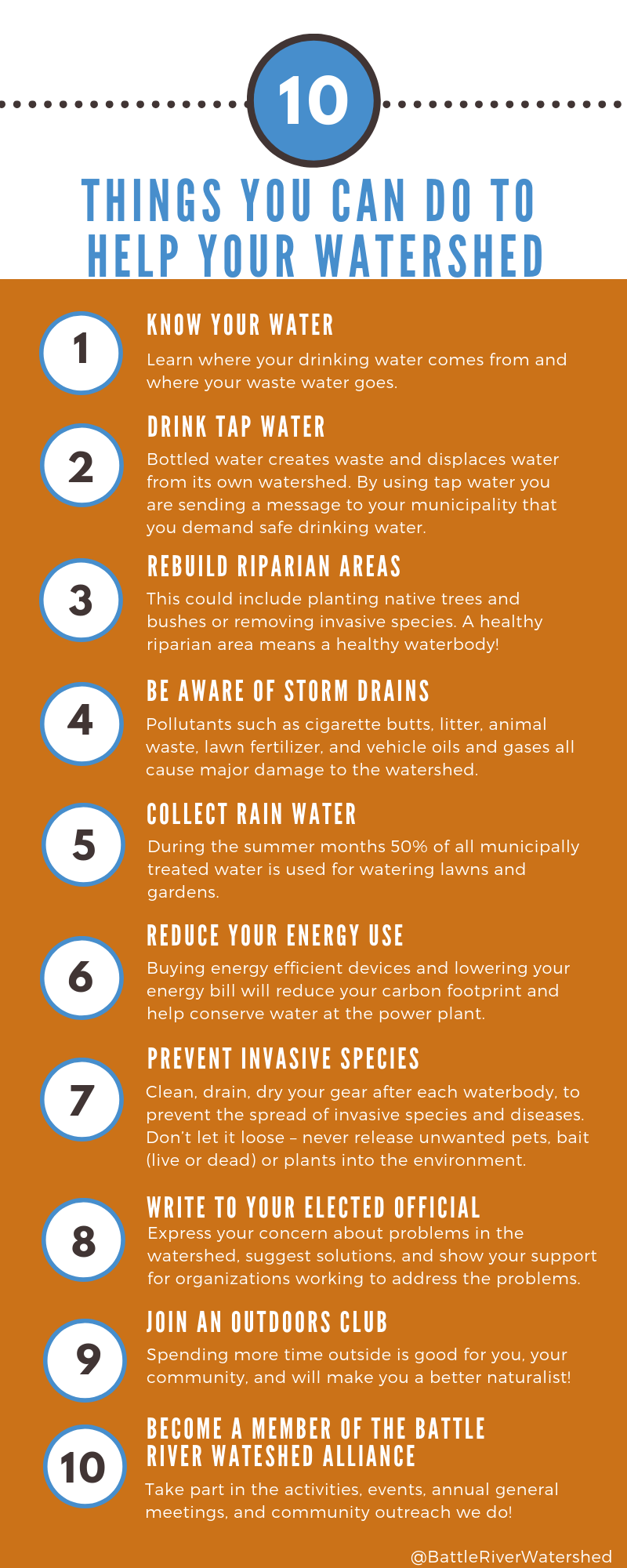Our Watersheds
Battle River Watershed
The Battle River Watershed covers most of east-central Alberta and drains into the Battle River. The Battle River itself is a modest, prairie-fed (as opposed to glacier-fed) river that lies within a valley that seems much too big for it. That’s because its path was carved out long ago when glacial meltwaters from prehistoric Lake Edmonton gushed southward, carving a large valley into the earth.
The Battle River Watershed (see map here) is approximately 30,000 square kilometres (17,667 square miles). Eighty-three per cent of this area is in Alberta; the remainder is in Saskatchewan.
Sounding Creek Watershed
Sounding is a unique watershed in Alberta. It is a closed basin, meaning that the water does not flow to the ocean. Sounding Creek flows into Sounding Lake, which then flows via Eyehill Creek into Manitou Lake in Saskatchewan. There is no outflow from Manitou Lake, and all the water that ends up there will stay there or be transported elsewhere through evaporation. See a map of the Alberta portion of Sounding Creek.
What exactly is a watershed?
A watershed is like a funnel, collecting rain and snow and draining it into a larger body of water (such as a wetland, stream, river or lake). Watersheds can be very small, such as around a lake, or very large, like all of the land that drains into Hudson Bay.
Within the complex living system of a watershed, everything is connected by the shared water and land. The Battle River starts at Battle Lake and flows 800 kilometres eastward across central Alberta, eventually entering the North Saskatchewan River at Battleford, Saskatchewan. The Battle River watershed contains all lands that drain into the Battle River. A number of creeks in the watershed feed into the Battle River, including Pipestone, Iron, Paintearth, Ribstone, and Pigeon Lake creeks. See a map of the subwatersheds.
As precipitation falls, it is stored in the watershed’s land and water bodies and slowly released through shallow water discharge into the river.
How many watersheds are there in Alberta?
There are seven major watersheds in Alberta: the Peace/Slave, Athabasca, Hay, North Saskatchewan, South Saskatchewan, Beaver, and Milk. The Battle River watershed is a sub-basin of the North Saskatchewan Watershed; the Battle River flows into the North Saskatchewan River at Battleford, Saskatchewan.
What is the history of the Battle River?
The Battle River has a long and important history in central Alberta. The Battle River has First Nations significance in terms of territorial mapping and historical events. In earlier times, the Battle River hunting grounds were contested between the Cree Nation, primarily in central and northern Alberta, and the Blackfoot Nation, primarily in southern Alberta. Other locations along the Battle River also have historical significance, such as the Neutral Hills and Dried Meat Lake. The Battle River also played an important role as settlers moved west to claim homesteads in the late 1800s and early 1900s. Settlers relied on the Battle River and its tributaries as a water source, a transportation corridor, and for agriculture. The Battle River was an important source of water for early railroads. The Battle River and its water levels have changed over time in response to climatic and ecological variations.

the watershed today
Click an icon on the map or use the settings in the upper-left to explore the points of interest.
What makes THE Battle River Watershed unique?
The natural lands, abundant wetlands, and riparian areas in the Battle River watershed make it an extremely rich and diverse landscape. The Battle River provides critical habitat for numerous wildlife species, including waterfowl, songbirds, ungulates, and various sportfish. It also contributes to the quality of life of local residents and visitors. The fact that the Battle River is prairie fed, not glacial fed like many other rivers in Alberta, also makes it unique.
Why is the Battle River watershed important?
The Battle River is the lifeblood of the Parkland Natural Region in east-central Alberta, supplying important water resources and an aquatic environment to plants, fish, and wildlife. The Battle River provides free ecosystem services to everyone in the watershed, including supplying and purifying water, reducing floods, offsetting drought, improving soil fertility, providing food and habitat, and providing beauty and recreation opportunities.
Maintaining these ecosystem services is essential to protecting the health and function of the watershed. A healthy, functioning watershed ensures sufficient flows and water quality for human needs and is important for protecting the ecosystem and biodiversity of the Battle River.
Municipalities rely on the Battle River system for drinking water, household use, business, and industry. Agriculture uses the river for irrigation, stock watering, and intensive agriculture. Industry uses the river for power generation and oilfield injection. Residents use the river for recreational fishing, canoeing, and boating.
The Battle River also supports the most important fishery in east Central Alberta. Walleye, mooneye and goldeye can be found below the Forestburg Dam, and northern pike can be found both above and below it.

The Battle River watershed provides critical habitat for numerous wildlife species, including waterfowl, songbirds, ungulates, and a number of species considered to be endangered or threatened, including the piping plover, northern leopard frog, peregrine falcon, ferruginous hawk, burrowing owl, Sprague’s pipit, loggerhead shrike, long-billed curlew, and prairie falcon.
Some experts have calculated that the ecosystem services provided by the Battle River are approximately $3.5 million per year; the Battle River’s floodplains and wetlands provide an additional $80 million per year.
The Battle River Watershed Management Planning Process is divided into two phases:
Phase 1 was led by Alberta Environment and Parks. After extensive public consultation, it resulted in the development of an Approved Water Management Plan.
Phase 2 is led by BRWA and its Watershed Management Plan.
How do my activities impact the Battle River watershed?
We are all stewards of the Battle River watershed, and what we do affects downstream and future users. From drinking water, to doing laundry, to fishing or using water for agriculture or industrial uses, everyone impacts the watershed they live in. Everything we do affects the watershed, whether at home, work or play. Household soaps, cleaners, pollutants from lawns, roads and driveways – even pharmaceuticals in household wastewater – can end up back in the river. Urban development and shoreline landscaping, as well as recreational activities on or close to rivers and streams, can also impact water quantity and quality.
Need more?
Purchase a copy of our Atlas: Traversing Terrain and Experience. It is chalk full of stories, photos, art, facts, and maps about what makes our watershed unique.


What you can do to protect the watershed
Simple, everyday actions help!
- Pick up pet waste
- Avoid putting toxic products down the drain
- Use environmentally friendly products around the home and garden
- Soil test to prevent overusing phosphorus fertilizer
Residents of the Battle River watershed recognize the importance of wise water use and many are already taking steps to improve their water conservation efforts. These include:
- Reducing lawn watering
- Using low-flow fixtures such as toilets and showerheads
- Using energy-efficient appliances (such as an Energy Star dishwasher)
Such steps may mean that future demands for water can be adequately met. By responsibly managing and conserving water, the environmental, economic, and social health of the Battle River watershed can be protected and enhanced. Recognizing the importance of living within the capacity of the Battle River watershed is a means of ensuring the sustainability of this important natural resource.

